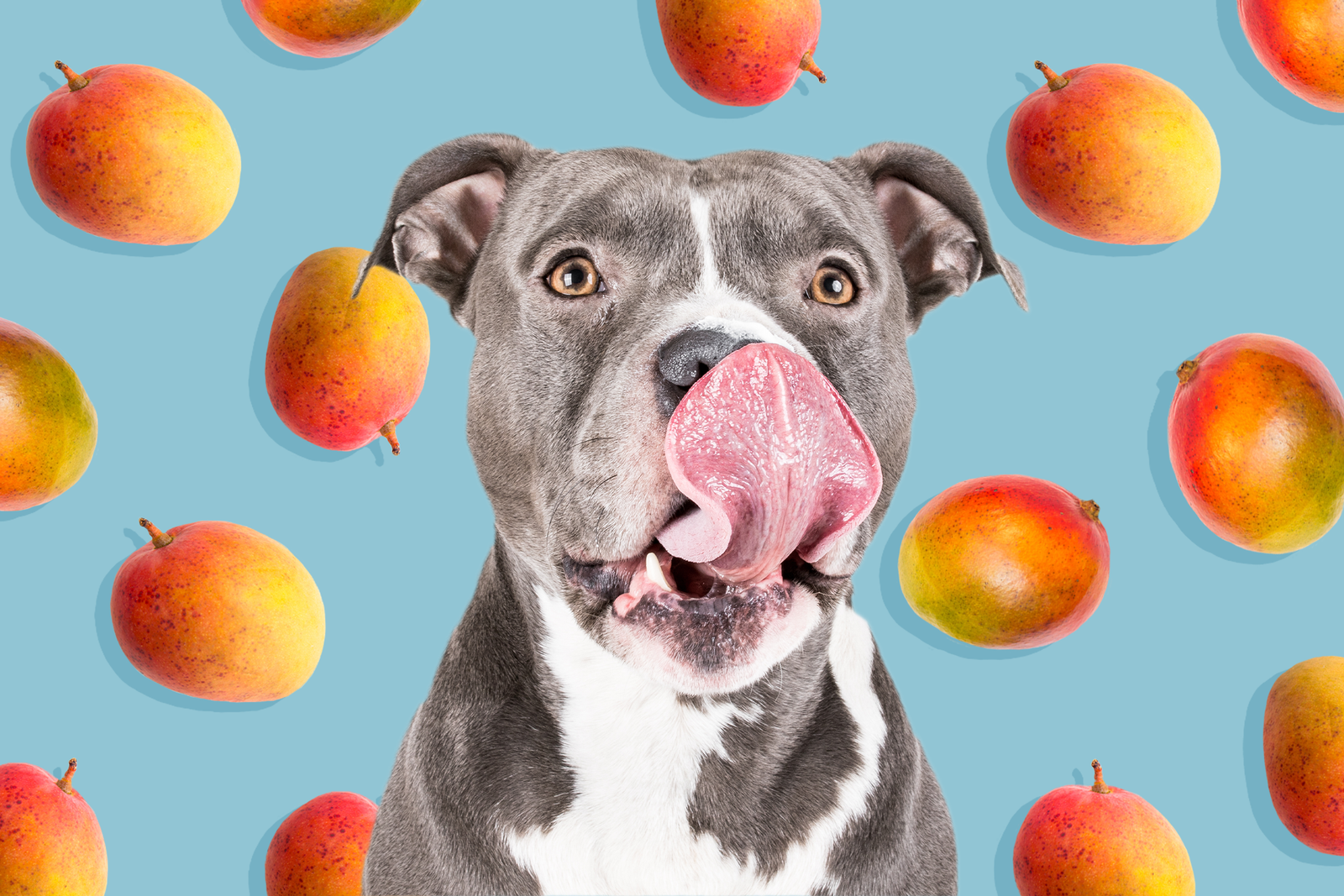Mangos are known as the “king of fruits” because of their nutritional value. They are low in calories yet chock-full of vitamins, minerals, and antioxidants. Above all, these sweet and delicious tropical fruits are also safe for our dogs.
If you love feeding your dog fruits as a snack in between meals, you can definitely add mango in the next rotation. But first, let’s take a deeper look into the various health benefits this fruit offers for our furry friends.

5 Health Benefits of Mangos for Dogs
Below are the five amazing health benefits of feeding mangos to your dog.
1. Aids Digestive Health
Mangos contain both soluble and insoluble fibers that can be beneficial for healthy digestion and bowel regularities. The insoluble fiber prevents constipation by increasing the speed of food through the stomach and intestines. It also adds bulk to the stool.
Whereas soluble fiber prevents diarrhea by absorbing excess fluids inside the stomach. It also gets fermented to produce short-chain fatty acids. These fatty acids then help support the growth of good bacteria and prevent the overgrowth of bad bacteria inside your dog's colon.
Adding high-fiber food items like mango to your dog’s diet can also help prevent sudden blood-sugar spikes and help reduce their cholesterol levels.
2. Supports Immune System
Mangos are a great source of vitamin C, which is known for its immune-boosting benefits. This vitamin can help increase the level of antibodies and the activity of the white blood cells that aid the dog’s body in fighting infections.
Vitamin C is also a powerful antioxidant that scavenges harmful free radicals and helps prevent chronic inflammation and arthritis in older dogs.
3. Provides Many Nutrients
Mangos are full of vitamins and minerals. They’re especially rich in potassium, which is an electrolyte that helps regulate fluid balance, muscle contractions, and nerve signals.
Mangos also contain other minerals like calcium, magnesium, and phosphorus. These minerals play many vital roles in a dog’s body as they help promote bone development, muscle health, proper kidney function, and heart health.
Additionally, mangos provide many vitamins, including vitamins A, B6, C, K, E, folate, and niacin. Each of these vitamins offers various benefits and helps keep our dog’s body functioning properly.
4. Reduces Inflammation
Mangos contain various antioxidants, including polyphenols, beta-carotene, carotenoid (lutein and zeaxanthin), and vitamin C. These antioxidants help the body fight against free radicals and prevent chronic inflammation.
They also help prevent various other health issues, including eye problems, skin allergies, respiratory diseases, autoimmune disorders, arthritis, and heart diseases in dogs.
5. Provides Hydration
A fresh mango consists of 84% water and almost no fat. You can feed them to your dog after a play session or a walk to help rehydrate and re-energize their body.
But please remember that mangos aren’t a substitute for drinking water. You should ensure that your dog has access to fresh drinking water to avoid dehydration, especially during the summer.

How to Feed Mangos to Your Dog
Now that you know mangos are safe and healthy for dogs, let’s discuss how you can add this delicious fruit to their diets.
Monitor the Portion Sizes
Your dog will probably love mangos due to their sweet and juicy taste. But it’s important to avoid any overindulgence and consider mango as a special treat for your dog. It would be ideal to follow the 90/10 rule that states 90% of your dog’s daily calories come from a complete and balanced diet and the remaining 10% from treats like mangos.
You should also avoid feeding mangos to your dog every day as it contains a high amount of natural sugar. This fruit should be considered an occasional treat that your dog eats once or twice a week.
You can also consult with your veterinarian to determine the exact amount of mango to feed your dog. They’ll be able to better advise you based on your dog’s health conditions, nutritional requirements, age, and weight.

Remove the Skin & Pit Before Feeding
When it comes to feeding mango to your dog, the best thing is to start with fresh and ripe fruit. You should always remove the skin of the mango as it contains urushiol, a compound that can irritate the dog’s skin. The skin is also hard to chew and digest and can lead to an upset stomach or intestinal obstruction.
The pit of the mango is also not safe as it can be a choking hazard. It also contains a small amount of cyanide which can be toxic for dogs.
Thus you should remove and discard the skin and the pit of the mango before feeding the fruit to your dog.

Fun Ways to Feed Mango to a Dog
You can simply chop the mango flesh into small bite-size pieces for your dog. If you want to try some more fun recipes, below are a few suggestions:
- Freeze a few slices for a chill summer snack
- Make mango puree with other dog-friendly ingredients like yogurt
- Make a smoothie with mango and other dog-friendly fruits like blueberries and banana
- Make ice pops with mango juice
- Mash the fruit and freeze it in ice cubes or stuff their KONG toy
- Make mango ice cream with dog-friendly ingredients
- Dehydrate a few slices to make a chewy snack
Are There Any Possible Dangers of Feeding Mango to a Dog
Mango is a safe and healthy snack for a dog but in moderation. The biggest danger about the fruit is the high sugar content which can be problematic when eaten in large quantities. It can lead to various health complications like obesity, diabetes, and digestive issues and can also compromise their oral health.
To avoid this, make sure that mangos only make up 10% of your dog’s daily diet. Also, avoid feeding mangos to your dog every day. Consider the fruit as an occasional treat for your dog.
Furthermore, if your dog is suffering from any prior health conditions like obesity or diabetes, consider consulting your veterinarian before adding new fruits into their diet.
Mango Allergy & Food Intolerances
There are no documented cases of a mango allergy in dogs, but you should still be careful when feeding mango for the first time. Your dog might not react well to mango due to the high fiber or the natural sugar content.
Start by feeding them a small bite-size piece of mango and monitor their reaction for 24-48 hours. If you notice any signs of digestive issues like diarrhea, constipation, or vomiting, don’t feed them any more mango.
In such cases, you should consult with a veterinarian to talk about your dog's intolerances and health complications.
Summing Up
Mangos are a delicious and refreshing tropical fruit that can be a great treat for your dog. The high fiber content and antioxidant properties of mangos can enrich your dog’s daily diet, and the vitamins and minerals can help support their overall health.
Just be cautious about the portion sizes and feed your dog a few slices of mango as an occasional treat. Also, remember to safely remove and discard the skin and pit of the mango before feeding the fruit to your pup.
If you have any further doubts, you can consult with your veterinarian before feeding mango to your dog.

FAQs
Let’s answer some frequently asked questions about feeding mangos to a dog.
1. How much mango can a dog eat?
Ideally, you should follow the 90/10 rule that states 90% of your dog’s daily calories come from complete and balanced meals and the remaining 10% from treats like mangos. You should also ensure that your dog isn’t eating a mango every day. It should be considered an occasional treat.
If you’re confused about the portion sizes, you can consult with a veterinarian to determine the exact amount of mango to feed your dog.
2. Can a dog eat mango pits?
No, dogs shouldn’t eat a mango pit as it contains a small amount of cyanide which can be toxic to their health. The pit can also be a potential choking hazard.
3. Can a dog eat mango skin?
No, dogs shouldn’t eat mango skin as it contains urushiol, a compound that can irritate their skin. Also, the mango skin can be hard to chew and digest and can lead to an upset stomach or intestinal obstruction.
4. Can a dog eat dried mango?
You can feed your dog dried mango but in small amounts. It is high in sugar and can lead to various health problems when eaten in large amounts.
If you’re buying dried mango from the store, make sure it doesn’t contain any other ingredients or seasoning which can be harmful to your dog.
Join Our Pack
Sign up for our monthly newsletter focused on dog digestion health, cute pup stories, and the latest scoop from Nextrition.
Sources:
https://www.akc.org/expert-advice/nutrition/can-dogs-eat-mango/





